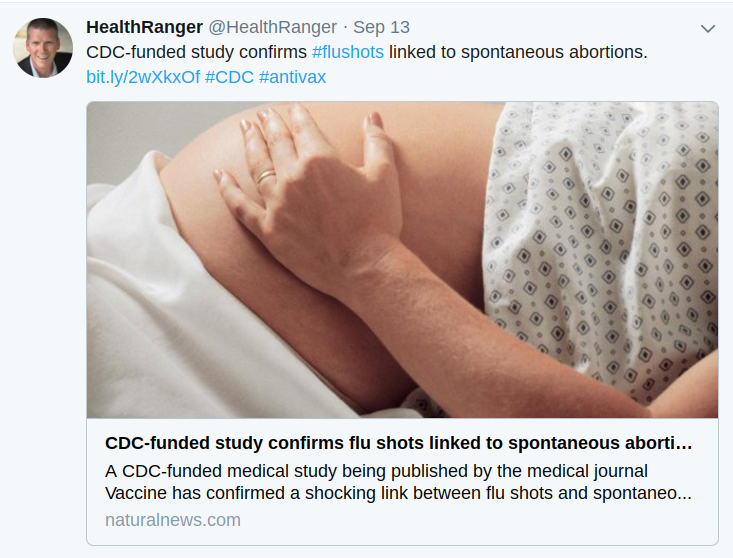The media has been having a field day with a recently published paper. That's not atypical when a scientific paper has a splashy result. Big scientific discoveries deserve a lot of attention.
The problem is that this paper is not a big scientific discovery. In fact, it is somewhat surprising that it was published in the journal that it was (Vaccine) - let alone be written up in major newspapers.
The headlines say that the paper shows a link between pregnant women receiving the flu vaccine in the first trimester and miscarriages. Regardless of the quality of the science, this will almost certainly result in two things. The first is that pregnant women will second guess getting their flu vaccine - and potentially other vaccines as well. The second is that the anti-vaxx community will latch onto this and use it to fuel their fire. In fact, it's like throwing kerosene on it - seen in the tweet from an anti-vaxx head honcho Mike Adams (aka The Health Ranger). His 116,000 twitter followers now think that his anti-vaxx claims are seemingly well supported.

The study was a case control study, meaning that the researchers matched 485 women who had miscarriages (called spontaneous abortions or SAB) within the 5th to 20th week of pregnancy with women similar in age and other factors who had live births or stillbirths after 20 weeks. Then, they looked for factors that differed between the two.
They used a statistic called an adjusted odds ratio (aOR) which indicates the level of association between an exposure and an outcome. More accurately, the odds that an outcome will occur given a particular exposure, compared to the odds of the outcome occurring in the absence of that exposure. (1)
They compared different factors among these two groups of women - one of which was the rate of flu vaccination in each group. Each way that they looked at it, the odds ratio did not change - except one. Women who had miscarriages were more likely to have received the flu vaccine within 28 days of the miscarriage - but only if they had received the H1N1 flu vaccine the year prior as well. This aOR was 7.7 - calculated from just 14 of the 485 cases.
The main conclusion is the result of sifting through the weeds to find a correlation. In addition, the experimental design is full of holes, too. For example, they cannot tell when the miscarriage occurred, may not know if someone had a miscarriage but didn't know it, may have skewed their data because women who had risk factors for miscarriage may have been more likely to receive the vaccine, and may not even have had accurate reporting on who had the flu shot because anyone can get a flu shot anywhere so they are relying on accurate reporting by individuals.
When reading the paper, you get the sense that the authors have reservations, as they have more qualifiers in their paper than data. Some examples are,
- "analyses with relatively small numbers of matched pairs may be more susceptible to chance associations"
- "the biological basis for our observations has not been established"
- the finding was "not an a priori hypothesis; the results were generated in a post hoc analysis with small numbers of women in the various subgroups."
- "This study does not and cannot establish a causal relationship between repeated influenza vaccination and SAB, but further research is warranted"
In doing this, they openly admit that their data are nothing more than preliminary results. But, they published it anyway - creating a maelstrom of fodder for the anti-vaxx community and opening up the window of doubt on the safety of vaccines. It will just be a matter of time until the flu vaccination rate drops, pregnant moms start getting sick followed by their kids at home. That is something that these researchers will have to carry on their conscience as will every media organization that promoted this weak conclusion.
References
(1) Szumilas M, Explaining Odds Ratios J Can Acad Child Adolesc Psychiatry. 2010 Aug; 19(3): 227–229. https://www.ncbi.nlm.nih.gov/pmc/articles/PMC2938757/

